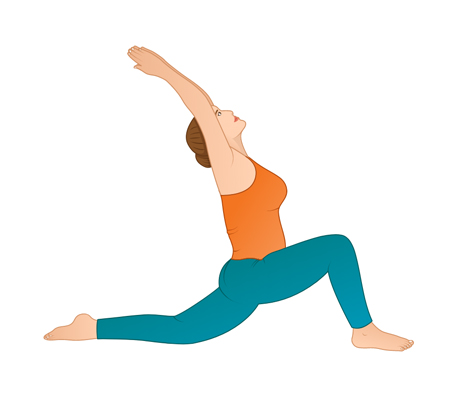Low Lunge Pose
Anjaneyasana

STEPS
Low lunge is a basic standing pose that stretches and strengthens the whole body. Low lunge is appropriate for all levels of classes from pre-natal to advanced styles of yoga. Runners will particularly appreciate the strong stretch in hamstrings and hip flexors.
To enter the pose, begin in Tadasana. On the inhale, raise the arms overhead, exhale to standing forward bend. Inhale, look up and place the hands on either side of the feet. Exhale, step the right back to high lunge. Exhale, bend the left leg and bring the knee to the mat. Inhale raise arms overs overhead. Exhale, sink the hips, draw the tail bone and lift the pubic bone towards the navel. To deepen the pose, arch the back, sternum and eye gaze upward. To exit the pose, lower the arms. Place hands on either side of right foot. Step the back foot forward. On the exhale, releases to a forward bend. Inhale back to Tadasana. Repeat other side
TEACHER QUEUES
VISUALIZATION COMMENTS
Visualise back hip, knee and foot in a straight line. On the inhale, imagine breathing warm heat into the hips and pelvis. On the exhale visualise that energy radiating throughout your body.
TECHNICAL COMMENTS
When stepping back to lunge, keep front knee over the ankle. Then release back knee to mat, stabilise, and slide back knee along the mat to a comfortable stretch. Press front big toe mound into the mat to ground the foot. Sink the hips, sliding them forward. Now, allow the front knee to move in front of the ankle. When raising the arms, align biceps with the ears. To complete the pose, lift the sternum and arch the back to avoid compressing neck, when gazing upwards. Breathe normally.
BENEFIT COMMENTS
- Stretches and strengthens entire body
- Tones abdominal organs
- Stretches and strengthens hips, flexors, hamstrings, quadriceps, ankles
- Stretches psoas and lower back muscles
- Improves back strength
- Opens chest and improves respiratory system
- Calms the mind and balances nervous system
WATCH OUT FOR
- Tight hips
- Sore knees
- Tight hip flexors, hamstrings, quads
- Falling out of the pose/balance issues
CONTRAINDICATIONS
- Knee injuries (see chair yoga)
- Lower back and neck injuries (avoid back arch/keep hands on blocks or wall/eye gaze ahead.
MODIFICATIONS
- Place hands on blocks, knee on folded blanket.
- Place chair under front thigh for support.
- Move front foot out to side making more room for hips to move forward.
- Practice with hands or back foot pressing against wall.
VARIATIONS
- Place hands on inside of right foot (lizard)
- Place elbows on mat or blocks to inside of front foot.
- Bend back foot up and bind.
- Roll onto outside of front foot, bend back foot up and bind. (blind lizard)
- Curl toes and lift back knee off floor.
YOGA COUNTER POSES
- Downward facing dog (Adho Mukha Svanasana)
- Standing forward bend (Uttanasana)
- Plank pose ( Phalakasana)
- Splits (Hanumanasana)
Written By: Brenda Hamlet
Brenda Hamlet is a RYT 200 yoga teacher and journalist. More information about Brenda can be found at https://www.facebook.com/brendahamletyoga



